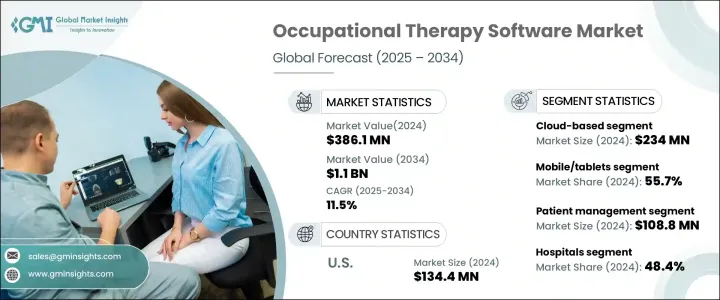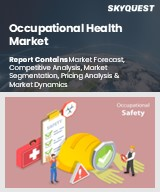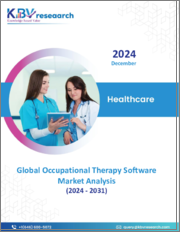
|
시장보고서
상품코드
1684615
작업치료 소프트웨어 시장 기회, 성장 촉진 요인, 산업 동향 분석, 예측(2025-2034년)Occupational Therapy Software Market Opportunity, Growth Drivers, Industry Trend Analysis, and Forecast 2025 - 2034 |
||||||
세계의 작업치료 소프트웨어 시장은 2024년에는 3억 8,610만 달러로 평가되었고, 2025년부터 2034년에 걸쳐 11.5% 연평균 복합 성장률(CAGR)로 성장할 것으로 예상됩니다.
이 역동적인 시장은 작업 치료 전문가가 임상과 관리 업무를 효과적으로 관리할 수 있도록 설계된 디지털 솔루션을 중심으로 전개하고 있습니다. 환자 스케줄링, 치료 계획, 문서화, 인보이스 작성, 보고, 데이터 분석 등의 일련의 기능을 제공하는 작업 치료 소프트웨어는 치료사가 치료를 제공하고 치료 결과를 최적화하는 방법에 혁명을 가져왔습니다.

이 시장의 성장의 주요 원동력은 만성 질환과 신경 퇴행성 질환의 유병률 증가이며, 종종 운동 능력과인지 기능을 손상시키는 질병입니다. 세계적으로 고령화가 진행되고 있으며, 알츠하이머병, 파킨슨병, 뇌졸중 등의 질병이 만연함에 따라 고급 치료 관리 도구에 대한 수요가 급증하고 있습니다. 이러한 디지털 솔루션은 임상가에게 실시간으로 환자의 경과를 추적하고, 치료 전략을 정교하게 하며, 전반적인 치료 효율을 향상시키는 수단을 제공합니다. 또한 원격 의료 및 원격 모니터링의 이점에 대한 인식이 높아지고 있다는 것은 건강 관리 환경 전반에 걸쳐 이러한 혁신적인 플랫폼의 채택을 뒷받침하고 있습니다.
| 시장 범위 | |
|---|---|
| 시작연도 | 2024 |
| 예측연도 | 2025-2034 |
| 시작금액 | 3억 8,610만 달러 |
| 예측 금액 | 11억 달러 |
| CAGR | 11.5% |
시장은 배포 모드별로 클라우드 기반과 웹 기반 솔루션으로 구분되며 클라우드 기반 부문은 압도적인 힘을 보이고 있습니다. 2024년 2억 3,400만 달러의 수익을 창출한 클라우드 기반 플랫폼은 예측 기간 동안 강력한 성장을 유지할 것으로 예상됩니다. 이러한 시스템은 확장성이 높고 개인 개업의에서 대규모 조직에 이르기까지 다양한 의료 진료의 요구를 충족시킬 수 있기 때문에 특히 유리합니다. 클라우드 기반 솔루션은 데이터 및 중요한 기능에 대한 원격 액세스를 가능하게 함으로써 여러 위치에 걸쳐 업무를 간소화하고 원격 의료 세션의 효율성을 높입니다.
사용자 인터페이스는 또한 중요한 부문이며 모바일, 태블릿 플랫폼과 데스크톱, 랩톱 플랫폼으로 나뉩니다. 2024년 시장의 55.7%를 차지한 모바일,태블릿 카테고리는 향후 수년간 크게 확대될 것으로 전망됩니다. 휴대성 및 실시간 기능을 갖춘 모바일 애플리케이션을 통해 치료자는 클리닉, 환자 집, 지역 밀착형 케어 모두 세션 중에 치료 계획 업데이트, 진행 상황 기록, 환자 데이터 관리를 할 수 있습니다. 이러한 인터페이스는 대화식으로 사용하기 쉽도록 설계되었으며 특히 즉각적인 피드백이 중요한 환경에서 치료사와 환자 간의 깊은 관계를 촉진합니다.
미국의 작업치료 소프트웨어 시장은 2024년에 1억 3,430만 달러를 창출해 세계 시장을 견인했습니다. 일본의 고급 의료 IT 인프라와 디지털 건강 변화를 추진하는 연방 정부의 이니셔티브는 전문 소프트웨어 솔루션의 보급에 박차를 가하고 있습니다. 미국에 본사를 둔 클리닉은 전자 의료기기(EHR) 및 원격 의료 플랫폼과 같은 도구를 통합하여 치료 서비스의 효율성과 효율성을 높이고 있으며 이 시장의 큰 성장을 이끌고 있습니다. 디지털화와 자동화의 추세는 미국을 작업 치료 소프트웨어의 혁신과 도입의 중요한 기반으로 자리매김하고 있습니다.
목차
제1장 조사 방법과 조사 범위
제2장 주요 요약
제3장 업계 인사이트
- 생태계 분석
- 업계에 미치는 영향요인
- 성장 촉진요인
- 만성 질환 및 신경퇴행성 질환의 유병률 증가
- 디지털 헬스 솔루션의 채용 확대
- 기술의 진보
- 환자 중심의 케어에 대한 주목의 고조
- 업계의 잠재적 위험 및 과제
- 높은 도입 비용
- 성장 촉진요인
- 성장 가능성 분석
- 규제 상황
- 미국
- 유럽
- 기술 동향
- 향후 시장 동향
- 주요 뉴스와 대처
- 갭 분석
- Porter's Five Forces 분석
- PESTEL 분석
제4장 경쟁 구도
- 소개
- 기업 점유율 분석
- 기업 매트릭스 분석
- 주요 시장 기업의 경쟁 분석
- 경쟁 포지셔닝 매트릭스
- 전략 대시보드
제5장 시장 추정 및 예측 : 전달 모드별, 2021년-2034년
- 주요 동향
- 클라우드 기반
- 웹 기반
제6장 시장 추정 및 예측 : 인터페이스별, 2021년-2034년
- 주요 동향
- 모바일, 태블릿
- 데스크톱, 노트북 PC
제7장 시장 추정 및 예측 : 용도별, 2021년-2034년
- 주요 동향
- 환자 관리
- 치료 계획
- 문서화 및 보고 작성
- 송장 작성
- 데이터 분석
제8장 시장 추정 및 예측 : 최종 용도별, 2021년-2034년
- 주요 동향
- 병원
- 진료소
- 기타 최종 용도
제9장 시장 추정 및 예측 : 지역별, 2021년-2034년
- 주요 동향
- 북미
- 미국
- 캐나다
- 유럽
- 독일
- 영국
- 프랑스
- 스페인
- 이탈리아
- 네덜란드
- 아시아태평양
- 중국
- 일본
- 인도
- 호주
- 한국
- 라틴아메리카
- 브라질
- 멕시코
- 아르헨티나
- 중동 및 아프리카
- 남아프리카
- 사우디아라비아
- 아랍에미리트(UAE)
제10장 기업 프로파일
- Advanced MD
- Care Patron
- CentralReach
- Clinic Source
- Fusion Web Clinic
- HENO
- Net Health
- Optima Health Care
- Oracle Cerner
- Planetrehab
- Practice Perfect EMR
- Practice Pro
- Simple Practice
- WebPT
The Global Occupational Therapy Software Market, valued at USD 386.1 million in 2024, is poised for remarkable growth, with projections estimating an impressive CAGR of 11.5% between 2025 and 2034. This dynamic market centers around digital solutions designed to empower occupational therapy professionals in effectively managing both clinical and administrative operations. Offering a suite of features such as patient scheduling, treatment planning, documentation, billing, reporting, and data analytics, occupational therapy software is revolutionizing how therapists deliver care and optimize outcomes.

A key driver behind the growth of this market is the increasing prevalence of chronic and neurodegenerative diseases, conditions that often impair mobility and cognitive function. As the global population ages and conditions such as Alzheimer's, Parkinson's, and stroke become more widespread, the demand for advanced therapy management tools has surged. These digital solutions provide clinicians with the means to track patient progress in real-time, refine treatment strategies, and improve overall care efficiency. Additionally, growing awareness of the benefits of telehealth and remote monitoring is encouraging the adoption of these innovative platforms across healthcare settings.
| Market Scope | |
|---|---|
| Start Year | 2024 |
| Forecast Year | 2025-2034 |
| Start Value | $386.1 Million |
| Forecast Value | $1.1 Billion |
| CAGR | 11.5% |
The market is segmented by delivery mode into cloud-based and web-based solutions, with the cloud-based segment emerging as the dominant force. Generating revenues of USD 234 million in 2024, cloud-based platforms are expected to maintain robust growth throughout the forecast period. These systems are particularly advantageous due to their scalability and ability to meet the diverse needs of healthcare practices, from solo practitioners to large organizations. By enabling remote access to data and critical functionalities, cloud-based solutions streamline operations across multiple locations and enhance the efficiency of telehealth sessions.
The user interface is another important segment, divided into mobile/tablet and desktop/laptop platforms. The mobile and tablet category, which accounted for 55.7% of the market in 2024, is anticipated to see significant expansion in the coming years. Mobile applications, with their portability and real-time capabilities, allow therapists to update treatment plans, document progress, and manage patient data during sessions, whether in a clinic, at a patient's home, or through community-based care. These interfaces are designed to be interactive and user-friendly, fostering greater engagement between therapists and patients, particularly in settings where immediate feedback is crucial.
The U.S. occupational therapy software market led the global landscape, generating USD 134.3 million in 2024. The country's advanced healthcare IT infrastructure and federal initiatives promoting digital health transformation have spurred widespread adoption of specialized software solutions. By integrating tools such as electronic health records (EHRs) and telehealth platforms, U.S.-based practices are enhancing the efficiency and effectiveness of therapy services, driving significant growth in this market. The trend toward digitalization and automation continues to position the U.S. as a key hub for innovation and adoption in occupational therapy software.
Table of Contents
Chapter 1 Methodology and Scope
- 1.1 Market scope and definitions
- 1.2 Research design
- 1.2.1 Research approach
- 1.2.2 Data collection methods
- 1.3 Base estimates and calculations
- 1.3.1 Base year calculation
- 1.3.2 Key trends for market estimation
- 1.4 Forecast model
- 1.5 Primary research and validation
- 1.5.1 Primary sources
- 1.5.2 Data mining sources
Chapter 2 Executive Summary
- 2.1 Industry 3600 synopsis
Chapter 3 Industry Insights
- 3.1 Industry ecosystem analysis
- 3.2 Industry impact forces
- 3.2.1 Growth drivers
- 3.2.1.1 Increasing prevalence of chronic and neurodegenerative diseases
- 3.2.1.2 Growing adoption of digital health solutions
- 3.2.1.3 Technological advancements
- 3.2.1.4 Rising focus on patient-centric care
- 3.2.2 Industry pitfalls and challenges
- 3.2.2.1 High implementation costs
- 3.2.1 Growth drivers
- 3.3 Growth potential analysis
- 3.4 Regulatory landscape
- 3.4.1 U.S.
- 3.4.2 Europe
- 3.5 Technology landscape
- 3.6 Future market trends
- 3.7 Key news and initiatives
- 3.8 Gap analysis
- 3.9 Porter's analysis
- 3.10 PESTEL analysis
Chapter 4 Competitive Landscape, 2024
- 4.1 Introduction
- 4.2 Company market share analysis
- 4.3 Company matrix analysis
- 4.4 Competitive analysis of major market players
- 4.5 Competitive positioning matrix
- 4.6 Strategy dashboard
Chapter 5 Market Estimates and Forecast, By Delivery Mode, 2021 – 2034 ($ Mn)
- 5.1 Key trends
- 5.2 Cloud-based
- 5.3 Web-based
Chapter 6 Market Estimates and Forecast, By Interface, 2021 – 2034 ($ Mn)
- 6.1 Key trends
- 6.2 Mobile/tablets
- 6.3 Desktops/laptops
Chapter 7 Market Estimates and Forecast, By Application, 2021 – 2034 ($ Mn)
- 7.1 Key trends
- 7.2 Patient management
- 7.3 Treatment planning
- 7.4 Documentation and reporting
- 7.5 Billing and invoicing
- 7.6 Data analytics
Chapter 8 Market Estimates and Forecast, By End Use, 2021 – 2034 ($ Mn)
- 8.1 Key trends
- 8.2 Hospitals
- 8.3 Clinics
- 8.4 Other end users
Chapter 9 Market Estimates and Forecast, By Region, 2021 – 2034 ($ Mn)
- 9.1 Key trends
- 9.2 North America
- 9.2.1 U.S.
- 9.2.2 Canada
- 9.3 Europe
- 9.3.1 Germany
- 9.3.2 UK
- 9.3.3 France
- 9.3.4 Spain
- 9.3.5 Italy
- 9.3.6 Netherlands
- 9.4 Asia Pacific
- 9.4.1 China
- 9.4.2 Japan
- 9.4.3 India
- 9.4.4 Australia
- 9.4.5 South Korea
- 9.5 Latin America
- 9.5.1 Brazil
- 9.5.2 Mexico
- 9.5.3 Argentina
- 9.6 Middle East and Africa
- 9.6.1 South Africa
- 9.6.2 Saudi Arabia
- 9.6.3 UAE
Chapter 10 Company Profiles
- 10.1 Advanced MD
- 10.2 Care Patron
- 10.3 CentralReach
- 10.4 Clinic Source
- 10.5 Fusion Web Clinic
- 10.6 HENO
- 10.7 Net Health
- 10.8 Optima Health Care
- 10.9 Oracle Cerner
- 10.10 Planetrehab
- 10.11 Practice Perfect EMR
- 10.12 Practice Pro
- 10.13 Simple Practice
- 10.14 WebPT



















